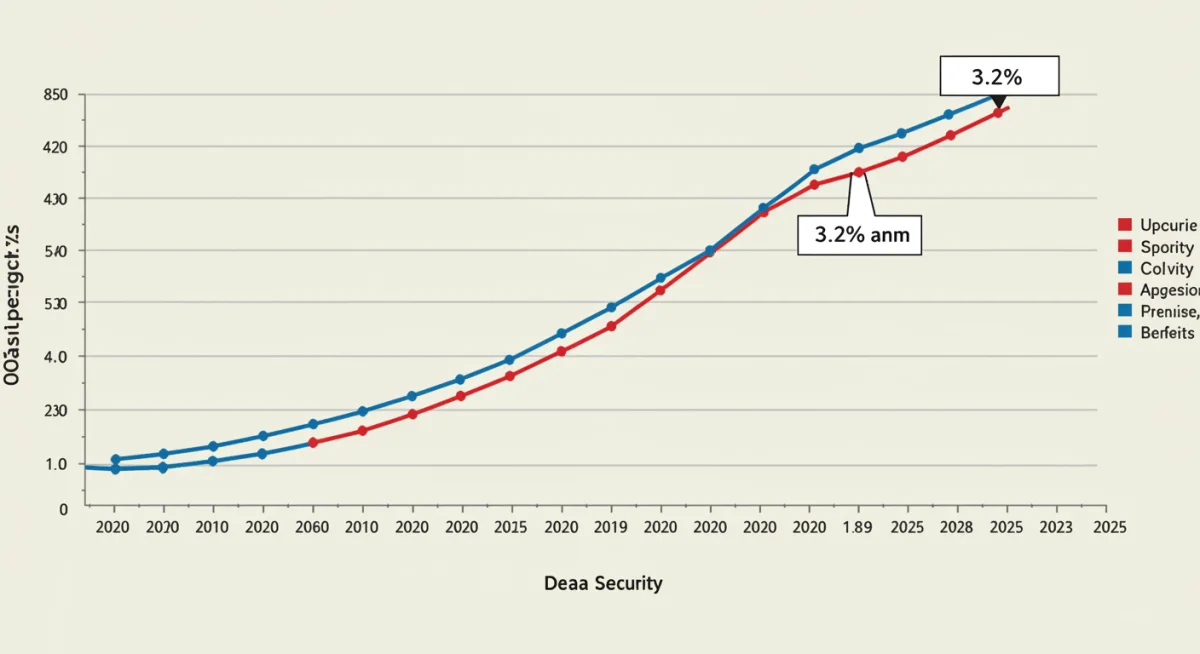Social Security COLA 2025: Expected 3.2% Increase

Anúncios
The Social Security Cost-of-Living Adjustment (COLA) for 2025 is projected to be approximately 3.2%, providing a vital boost to beneficiaries’ purchasing power.
As millions of Americans rely on Social Security benefits, understanding upcoming adjustments is crucial for financial planning. The anticipated Social Security COLA 2025, projected at 3.2%, represents a significant update that will influence the financial well-being of retirees, disabled individuals, and survivors across the nation. This adjustment aims to help beneficiaries keep pace with the rising cost of living.
Anúncios
Understanding the Cost-of-Living Adjustment (COLA)
The Cost-of-Living Adjustment, or COLA, is an annual increase in Social Security and Supplemental Security Income (SSI) benefits. Its primary purpose is to counteract the effects of inflation, ensuring that the purchasing power of benefits does not erode over time. Without COLA, the fixed income of beneficiaries would gradually buy less and less as prices for goods and services rise.
The calculation of COLA is a complex process, rooted in economic data. It is not an arbitrary decision but rather a mechanism tied directly to inflation indicators. This ensures that the adjustments are reflective of real-world economic conditions faced by millions of Americans. The Social Security Administration (SSA) announces the official COLA percentage in the fall, based on data from the third quarter of the current year.
Anúncios
How COLA is Calculated
The COLA is determined by the percentage increase in the Consumer Price Index for Urban Wage Earners and Clerical Workers (CPI-W) from the third quarter of the previous year to the third quarter of the current year. If there is no increase, there is no COLA. This specific index is chosen because it is believed to reflect the spending patterns of working Americans, which in turn influences the cost of living for retirees.
- CPI-W Data: The SSA uses CPI-W data from July, August, and September.
- Comparison Period: This data is compared to the CPI-W from the same three months of the prior year.
- Percentage Increase: The percentage difference becomes the COLA for the following year.
- No Decrease: Social Security benefits can never decrease due to COLA, even if the CPI-W declines.
Understanding the COLA mechanism is vital for beneficiaries. It provides a transparent and objective method for adjusting benefits, aiming to maintain financial stability for those who depend on Social Security. The projected 3.2% for 2025, while an estimate, offers an early look into potential financial shifts.
The Projected 3.2% Increase for 2025
The current projection for the Social Security COLA 2025 stands at approximately 3.2%. This figure is derived from various economic forecasts and preliminary inflation data, offering beneficiaries and financial planners an early indication of what to expect. While not yet official, such projections are often quite accurate due to the consistent methodology used by the Social Security Administration.
A 3.2% increase would translate to a noticeable boost in monthly benefits for millions. For example, a beneficiary receiving an average monthly payment would see their check increase by a specific dollar amount, helping to offset the rising costs of everyday essentials like groceries, utilities, and healthcare. This adjustment is particularly significant for individuals on fixed incomes, where every dollar counts.
Impact on Beneficiaries’ Wallets
While a 3.2% increase might seem modest to some, its cumulative effect over a year can be substantial. For individuals whose Social Security benefits represent a significant portion of their income, this adjustment can make a critical difference in their ability to meet financial obligations. It provides a necessary buffer against inflationary pressures that continually erode purchasing power.
- Increased Purchasing Power: Helps beneficiaries afford rising costs of goods and services.
- Financial Stability: Offers a degree of predictability for budgeting and financial planning.
- Healthcare Costs: Can partially offset increases in Medicare Part B premiums, which are often tied to COLA.
- Retirement Planning: Provides a clearer picture for those nearing retirement and planning their income streams.
The 3.2% projection for 2025 reflects ongoing inflationary trends in the U.S. economy. While lower than some recent COLA increases, it still signifies a positive adjustment aimed at preserving the financial well-being of Social Security recipients. It underscores the importance of staying informed about these annual adjustments.
Historical COLA Trends and Economic Context
Examining historical COLA trends provides valuable context for the projected 3.2% increase in 2025. Over the past few decades, COLA percentages have varied significantly, reflecting different economic environments. Periods of high inflation have led to substantial adjustments, while times of low inflation have resulted in minimal or even zero COLA increases. This variability highlights the dynamic nature of economic forces impacting Social Security benefits.
The recent past has seen some notable COLA increases, particularly in response to elevated inflation rates. For instance, the 2022 COLA was 5.9%, and the 2023 COLA reached 8.7%, marking the largest increase in decades. These larger adjustments were a direct consequence of the rapid rise in prices for consumer goods and services experienced during those years. The projected 3.2% for 2025, while lower than these recent peaks, suggests a moderation in inflationary pressures compared to preceding years, yet still indicates persistent cost-of-living increases.

Key Economic Factors Influencing COLA
Several economic factors play a crucial role in determining the annual COLA. These factors are constantly monitored by economists and policymakers, as they not only affect Social Security but also the broader economic landscape.
- Inflation Rates: The most direct influence, measured by the CPI-W. Higher inflation generally leads to higher COLA.
- Energy Prices: Fluctuations in oil and gas prices directly impact transportation and utility costs, feeding into inflation.
- Food Costs: Essential for all households, rising food prices significantly affect the cost of living index.
- Supply Chain Issues: Disruptions can lead to scarcity and increased prices for various goods.
- Wage Growth: While not directly used in COLA calculation, strong wage growth can indicate broader economic health and inflationary pressures.
Understanding these historical patterns and economic drivers helps beneficiaries anticipate and plan for future adjustments. The 3.2% projection for the Social Security COLA 2025 is a reflection of current economic forecasts, balancing the need to protect purchasing power with the evolving inflationary environment.
Who Benefits from the COLA and How
The Cost-of-Living Adjustment directly benefits a vast segment of the American population, extending beyond just retirees. Millions of individuals and families rely on Social Security for their financial stability, and the annual COLA ensures that these benefits retain their value against the backdrop of rising prices. This broad impact underscores the importance of the adjustment mechanism.
Primarily, retired workers and their spouses receive the COLA. However, the adjustment also applies to disabled workers receiving Social Security Disability Insurance (SSDI) and survivors of deceased workers, including widows, widowers, and eligible children. Furthermore, Supplemental Security Income (SSI) beneficiaries also see their payments adjusted by the same COLA percentage, ensuring a wide-reaching financial uplift.
Receiving Your Adjusted Benefits
Beneficiaries do not need to take any action to receive their COLA-adjusted benefits. The Social Security Administration automatically recalculates and applies the new payment amounts. Notifications are typically sent out in December, informing beneficiaries of their new monthly payment amount, which usually takes effect in January of the following year.
- Retired Workers: The largest group, seeing their retirement income adjusted.
- Spouses and Dependents: Eligible family members also receive adjusted benefits.
- Disabled Individuals: SSDI recipients benefit from increased financial support.
- Survivors: Widows, widowers, and children receive adjusted payments.
- SSI Beneficiaries: Payments for low-income individuals and those with disabilities are also adjusted.
The COLA plays a critical role in the financial planning of these diverse groups. For many, Social Security benefits are their primary or sole source of income, making these annual adjustments indispensable for managing daily expenses and maintaining a reasonable standard of living. The projected 3.2% for the Social Security COLA 2025 will therefore have a tangible positive impact on countless households.
Planning for the 2025 COLA: What You Should Do
While the official Social Security COLA 2025 announcement is still months away, the 3.2% projection offers a valuable opportunity for proactive financial planning. Understanding how this adjustment might impact your income can help you make informed decisions regarding your budget, savings, and investments. It’s never too early to start thinking about how changes in your benefit payments will affect your overall financial picture.
For current beneficiaries, this means reviewing your current expenses and anticipating how a slight increase in income could alleviate some financial pressures or allow for minor adjustments in spending. For those nearing retirement, it provides a clearer estimate of future income, which is crucial for determining retirement readiness and potential lifestyle choices. Financial planning is an ongoing process, and COLA projections are a key piece of that puzzle.
Practical Steps for Beneficiaries
Taking a few simple steps now can help you maximize the benefit of the upcoming COLA. These actions can range from reviewing your budget to exploring how the increase might affect other aspects of your financial life.
- Review Your Budget: Reassess your monthly income and expenses to see where the extra funds could be best utilized.
- Medicare Part B Premiums: Be aware that Medicare Part B premiums are often deducted from Social Security benefits and can also increase annually.
- Tax Implications: Depending on your total income, a portion of your Social Security benefits may be taxable. Consult a tax professional if you have concerns.
- Debt Management: Consider using any extra funds to pay down high-interest debt, improving your financial health.
- Savings Goals: Even a small increase can contribute to savings goals, especially if consistently applied.
Proactive planning ensures that beneficiaries are not caught off guard and can effectively integrate the COLA into their financial strategies. The 3.2% projected increase for 2025, though an estimate, empowers individuals to start these crucial planning conversations now.
Future Outlook and Long-Term Sustainability of Social Security
Beyond the immediate impact of the Social Security COLA 2025, it is important to consider the broader context of Social Security’s long-term sustainability. The program faces ongoing demographic and economic challenges, including an aging population and fluctuating birth rates, which continuously impact its financial health. Discussions about the future of Social Security are frequent among policymakers and economists, aiming to ensure its viability for future generations.
While annual COLAs are designed to protect current beneficiaries’ purchasing power, the long-term projections for Social Security’s trust funds indicate potential challenges. Without legislative action, there could be a point where the program is unable to pay 100% of promised benefits. This has led to various proposals for reform, ranging from adjustments to the retirement age to changes in how benefits are calculated or taxed.
Ongoing Debates and Potential Reforms
The debate surrounding Social Security’s future is complex, with various stakeholders proposing different solutions. These discussions are critical for maintaining public confidence in the program and ensuring its continued ability to serve its purpose.
- Raising the Retirement Age: A common proposal to reduce the total payout period per individual.
- Adjusting the COLA Formula: Considering alternative inflation measures, such as the Chained CPI, which typically results in lower COLAs.
- Increasing Payroll Taxes: Raising the Social Security tax rate or the amount of earnings subject to taxation.
- Means-Testing Benefits: Adjusting benefits based on a recipient’s total income or wealth.
- Investment Strategies: Exploring options for the trust funds to generate higher returns.
These potential reforms highlight the dynamic nature of Social Security and the ongoing efforts to secure its future. While the 3.2% COLA for 2025 addresses immediate purchasing power, the larger conversation about long-term sustainability remains a crucial aspect of national financial policy. Staying informed about these discussions is essential for all Americans, particularly those who will rely on Social Security in the years to come.
| Key Point | Brief Description |
|---|---|
| 2025 COLA Projection | Anticipated 3.2% increase for Social Security and SSI benefits. |
| COLA Purpose | Adjusts benefits to offset inflation and maintain purchasing power. |
| Calculation Basis | Determined by the Consumer Price Index for Urban Wage Earners (CPI-W). |
| Beneficiary Impact | Affects retired, disabled, and survivor beneficiaries automatically. |
Frequently Asked Questions About COLA 2025
The projected Cost-of-Living Adjustment (COLA) for Social Security in 2025 is approximately 3.2%. This estimate is based on current inflation trends and economic forecasts, though the official figure will be announced later in the year by the Social Security Administration.
The Social Security Administration typically announces the official COLA for the upcoming year in October. This announcement is based on the Consumer Price Index for Urban Wage Earners and Clerical Workers (CPI-W) data from the third quarter (July, August, and September).
Medicare Part B premiums are often deducted directly from Social Security benefits. While COLA increases your benefits, Part B premiums can also rise annually. The ‘hold harmless’ provision usually prevents your net Social Security benefit from decreasing due to Part B increases, but this is not always guaranteed for all beneficiaries.
No, you do not need to apply for the COLA increase. The Social Security Administration automatically adjusts benefits for all eligible recipients. You will receive a notification in December detailing your new monthly benefit amount, which will take effect starting in January of the following year.
The COLA percentage is primarily determined by the increase in the Consumer Price Index for Urban Wage Earners and Clerical Workers (CPI-W). This index measures changes in the prices of goods and services. The COLA aims to ensure that Social Security benefits keep pace with the cost of living.
Conclusion
The projected 3.2% Social Security COLA 2025 represents a crucial adjustment for millions of Americans relying on these benefits. This increase, though still an estimate, underscores the Social Security Administration’s commitment to helping beneficiaries maintain their purchasing power amidst ongoing inflationary pressures. By understanding how COLA is calculated, who it impacts, and how to plan for it, individuals can better manage their finances and secure their economic well-being. While the official announcement is pending, proactive engagement with these updates is vital for informed financial decision-making and ensuring a stable future for all Social Security recipients.





